#carlo böcklin
Explore tagged Tumblr posts
Text
Cross-posting an essay I wrote for my Patreon since the post is free and open to the public.

Hello everyone! I hope you're relaxing as best you can this holiday season. I recently went to see Miyazaki's latest Ghibli movie, The Boy and the Heron, and I had some thoughts about it. If you're into art historical allusions and gently cranky opinions, please enjoy. I've attached a downloadable PDF in the Patreon post if you'd prefer to read it that way. Apologies for the formatting of the endnotes! Patreon's text posting does not allow for superscripts, which means all my notations are in awkward parentheses. Please note that this writing contains some mild spoilers for The Boy and the Heron.

Hayao Miyazaki’s 2023 feature animated film The Boy and the Heron reads as an extended meditation on grief and legacy. The Master of a grand tower seeks a descendant to carry on his maddening duty, balancing toy blocks of magical stone upon which the entire fabric of his little pocket of reality rests. The world’s foundations are frail and fleeting, and can pass away into the cold void of space should he neglect to maintain this task. The Master’s desire to pass the torch undergirds much of the film’s narrative.

(Isle of the Dead. Arnold Böcklin. 1880. Oil on Canvas. Kunstmuseum. Basel, Switzerland.)
Arnold Böcklin, a Swiss Symbolist(1) painter, was born on October 16 in 1827, the same year the Swiss Evangelical Reformed Church bought a plot of land in Florence from the Grand Duke of Tuscany, Leopold II, that had long been used for the burials of Protestants around Florence. It is colloquially known as The English Cemetery, so called because it was the resting place of many Anglophones and Protestants around Tuscany, and Böcklin frequented this cemetery—his workshop was adjacent and his infant daughter Maria was buried there. In 1880, he drew inspiration from the cemetery, a lone plot of Protestant land among a sea of Catholic graveyards, and began to paint what would be the first of six images entitled Isle of the Dead. An oil on canvas piece, it depicts a moody little island mausoleum crowned with a gently swaying grove of cypresses, a type of tree common in European cemeteries and some of which are referred to as arborvitae. A figure on a boat, presumably Charon, ferries a soul toward the island and away from the viewer.
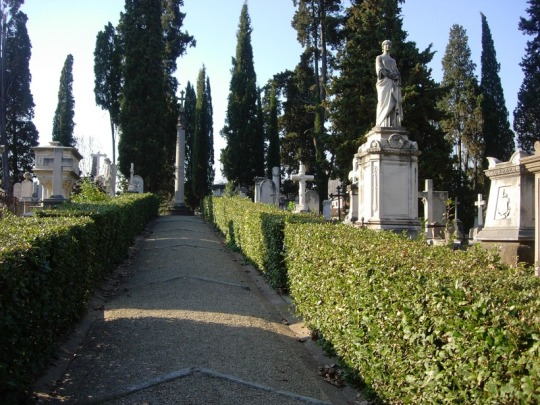
(Photo of The English Cemetery in Florence. Samuli Lintula. 2006.)
The Isle of the Dead paintings varied slightly from version to version, with figures and names added and removed to suit the needs of the time or the commissioner. The painting was glowingly referenced and remained fairly popular throughout the late 19th and early 20th centuries. The painting used to be inescapable in much of European popular culture. Professor Okulicz-Kozaryn, a philologist (someone with a deep interest in the ways language and cultural canons evolve)(2) observed that the painting, like many other works in its time, was itself iterative and became widely reiterated and referenced among its contemporaries. It became something like Romantic kitsch in the eyes of modern art critics, overwrought and excessively Byronic. I imagine Miyazaki might also resent a work of that level of manufactured ubiquity, as Miyazaki famously held Disney animated films in contempt (3). Miyazaki’s films are popularly aspirational to young animators and cartoonists, but gestures at imitation typically fall well short, often reducing Miyazaki’s weighty films to kitschy images of saccharine vibes and a lazy indulgence in a sort of empty magical domestic coziness. Being trapped in a realm of rote sentiment by an uncritical, unthoughtful viewership is its own Isle of Death.

(Still from The Boy and the Heron, 2023. Studio Ghibli.)
The Boy and the Heron follows a familiar narrative arc to many of Miyazaki’s other films: a child must journey through a magical and quietly menacing world in order to rescue their loved ones. This arc is an echo of Satsuki’s journey to find Mei in My Neighbor Totoro (1988) and Chihiro’s journey to rescue her parents Spirited Away (2001). To better understand Miyazaki’s fixation with this particular character journey, it can be instructive to watch Lev Atamanov’s 1957 animated film, The Snow Queen (4)(5), a beautifully realized take on Hans Christian Andersen’s 1844 children’s story (6)(7). Mahito’s journey continues in this tradition, as the boy travels into a painted world to rescue his new stepmother from a mysterious tower.
Throughout the film, Miyazaki visually references Isle of the Dead. Transported to a surreal world, Mahito initially awakens on a little green island with a gated mausoleum crowned with cypress trees. He is accosted by hungry pelicans before being rescued by a fisherwoman named Kiriko. After a day of catching and gutting fish, Mahito wakes up under the fisherwoman’s dining table, surrounded by kokeshi—little wooden dolls—in the shapes of the old women who run Mahito’s family’s rural household. Mahito is told they must not be touched, as the kokeshi are wards set up for his protection. There is a popular urban legend associated with the kokeshi wherein they act as stand-ins for victims of infanticide, though there seems to be very little available writing to support this legend. Still, it’s a neat little trick that Miyazaki pulls, placing a stray reference to a local legend of unverifiable provenance that persists in the popular imagination, like the effect of fairy stories passed on through oral retellings, continually remolded each new iteration.
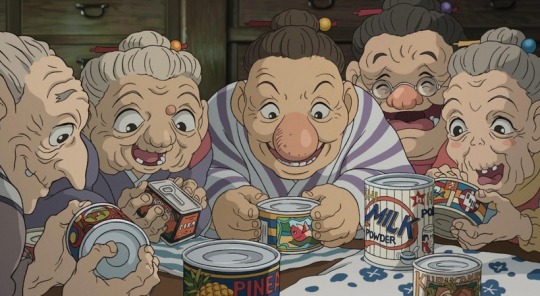
(Still from The Boy and the Heron, 2023. Studio Ghibli.)
Kiriko’s job in this strange landscape is to catch fish to nourish unborn spirits, the adorable floating warawara, before they can attempt to ascend on a journey into the world of the living. Their journey is thwarted by flocks of supernatural pelicans, who swarm the warawara and devour them. This seems to nod to the association of pelicans with death in mythologies around the world, especially in relationship to children (8). Miyazaki’s pelicans contemplate the passing of their generations as each successive generation seems to regress, their capacity to fulfill their roles steadily diminishing.
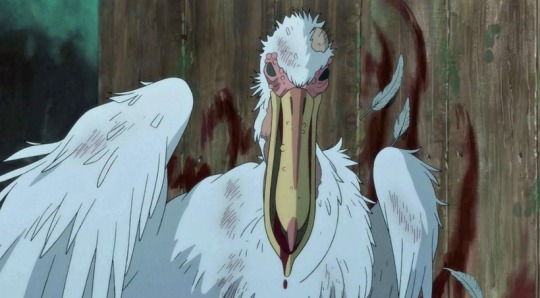
(Still from The Boy and the Heron, 2023. Studio Ghibli.)
As Mahito’s adventure continues, we find the landscapes changing away from Böcklin’s Isle of the Dead into more familiar Ghibli territories as we start to see spaces inspired by one of Studio Ghibli’s aesthetic mainstays, Naohisa Inoue and his explorations of the fantasy realms of Iblard. He might be most familiar to Ghibli enthusiasts as the background artists for the more fantastical elements of Whisper of the Heart (1995).

(Naohisa Inoue, for Iblard Jikan, 2007. Studio Ghibli.)
By the time we arrive at the climax of The Boy and the Heron, the fantasy island environment starts to resemble English takes on Italian gardens, the likes of which captivated illustrators and commercial artists of the early 20th century such as Maxfield Parrish. This appears to be a return to one of Böcklin’s later paintings, The Island of Life (1888), a somewhat tongue-in-cheek reaction to the overwhelming presence of Isle of the Dead in his life and career. The Island of Life depicts a little spot of land amid an ocean very like the one on which Isle of the Dead’s somber mausoleum is depicted, except this time the figures are lively and engaged with each other, the vegetation lush and colorful, replete with pink flowers and palm fronds.
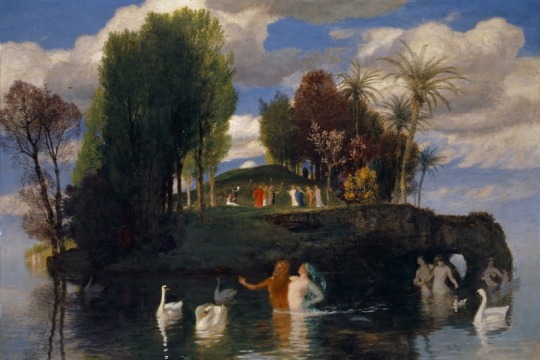
(Island of Life. Arnold Böcklin. Oil on canvas. 1888. Kunstmuseum. Basel, Switzerland.)
In 2022, Russia’s State Hermitage Museum in Saint Petersburg acquired the sixth and final Isle of the Dead painting. In the last year of his life, Arnold Böcklin would paint this image in collaboration with his son Carlo Böcklin, himself an artist and an architect. Arnold Böcklin spent three years painting the same image three times over at the site of his infant daughter’s grave, trapped on the Isle of the Dead. By the time of his death in 1901 at age 74, Böcklin would be survived by only five of his fourteen children. That the final Isle of the Dead painting would be a collaboration between father and son seemed a little ironic considering Hayao Miyazaki’s reticence in passing on his own legacy. Like the old Master in The Boy and the Heron, Miyazaki finds himself with no true successors.
The Master of the Tower's beautiful islands of painted glass fade into nothing as Mahito, his only worthy descendant, departs to live his own life, fulfilling the thesis of Genzaburo Yoshino’s 1937 book How Do You Live?, published three years after Carlo Böcklin’s death. In evoking Yoshino and Böcklin’s works, Hayao Miyazaki’s The Boy and the Heron suggests that, like his character the Master, Miyazaki himself must make peace with the notion that he has no heirs to his legacy, and that those whom he wished to follow in his footsteps might be best served by finding their own paths.
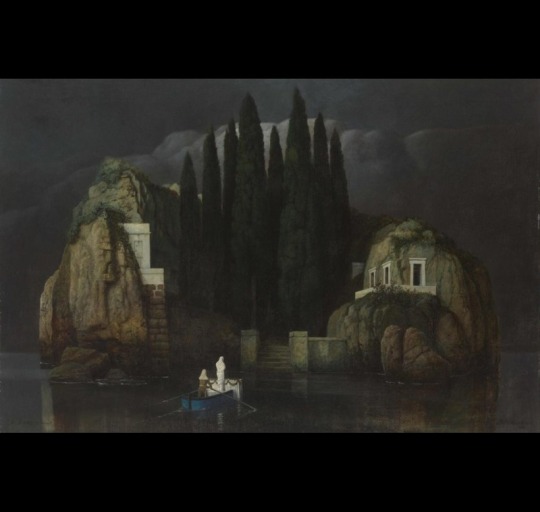
(Isle of the Dead. Arnold and Carlo Böcklin. Oil on canvas. 1901. The State Hermitage Museum. Saint Petersburg, Russia.)
INFORMAL ENDNOTES
1 - Symbolists are sort of tough to nail down. They were started as a literary movement to 1 distinguish themselves from the Decadents, but their manifesto was so vague that critics and academics fight about it to this day. The long and the short of it is that the Symbolists made generous use of a lot of metaphorical imagery in their work. They borrow a lot of icons from antiquity, echo the moody aesthetics from the Romantics, maintained an emphasis on figurative imagery more so than the Surrealists, and were only slightly more technically married to the trappings of traditionalist academic painters than Modernists and Impressionists. They're extremely vibes-forward.
2 - Okulicz-Kozaryn, Radosław. Predilection of Modernism for Variations. Ciulionis' Serenity among Different Developments of the Theme of Toteninsel. ACTA Academiae Artium Vilnensis 59. 2010. The article is incredibly cranky and very funny to read in parts. Contains a lot of observations I found to be helpful in placing Isle of the Dead within its context.
3 - "From my perspective, even if they are lightweight in nature, the more popular and common films still must be filled with a purity of emotion. There are few barriers to entry into these films-they will invite anyone in but the barriers to exit must be high and purifying. Films must also not be produced out of idle nervousness or boredom, or be used to recognise, emphasise, or amplify vulgarity. And in that context, I must say that I hate Disney's works. The barrier to both the entry and exit of Disney films is too low and too wide. To me, they show nothing but contempt for the audience." from Miyazaki's own writing in his collection of essays, Starting Point, published in 2014 from VIZ Media.
4 - You can watch the movie here in its original Russian with English closed captions here.
5 If you want to learn more about the making of Atamanoy's The Snow Queen, Animation Obsessive wrote a neat little article about it. It's a good overview, though I have to gently disagree with some of its conclusions about the irony of Miyazaki hating Disney and loving Snow Queen, which draws inspiration from Bambi. Feature film animation as we know it hadonly been around a few decades by 1957, and I find it specious, particularly as a comic artistand author, to see someone conflating an entire form with the character of its content, especially in the relative infancy of the form. But that's just one hot take. The rest of the essay is lovely.
6 - Miyazaki loves this movie. He blurbed it in a Japanese re-release of it in 2007.
7 - Julia Alekseyeva interprets Princess Mononoke as an iteration of Atamanov's The Snow Queen, arguing that San, the wolf princess, is Miyazaki's homage to Atamanoy's little robber girl character.
8 - Hart, George. The Routledge Dictionary of Egyptian Gods And Goddesses. Routledge Dictionaries. Abingdon, United Kingdom: Routledge. 2005.
#hayao miyazaki#the boy and the heron#how do you live#arnold böcklin#carlo böcklin#symbolists#symbolism#animation#the snow queen#lev atamanov#naohisa inoue#the endnotes are very very informal aksjlsksakjd#sorry to actual essayists
527 notes
·
View notes
Text





but i was not only going to hide a treasure–i meant also to bury a grief.
villette – charlotte brontë | isle of the dead – arnold böcklin (1886) | the juniper tree – the brothers grimm | death and the grave digger – carlos schwabe (1900) | there she is – linda gregg
#web weaving#or at least attempted#idk what this is but i read that passage in villette and it got me Thinking#villette#charlotte bronte#arnold böcklin#the brothers grimm#carlos schwabe#linda gregg#art#poetry#quote#mine
7 notes
·
View notes
Text
Enough frivolous debating!! Which version of "Isle of the Dead" by Arnold Böcklin is your favorite???
16 notes
·
View notes
Text
La Morte
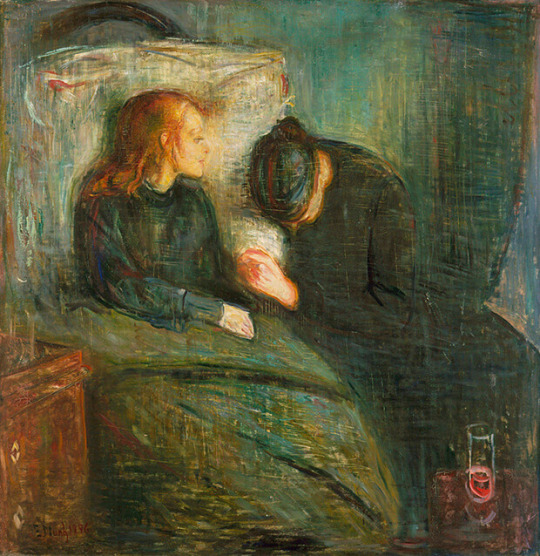
The sick child, 1896 | Edvard Munch (1863-1944, Norway)

Funerale bianco (White funeral), 1901 | Edoardo Berta (1867-1931, Italia)

Autoritratto macabro (macabre self-portrait), 1899 | Carlo Fornara (1871-1968, Italia)

Tombe romane (roman tombs), Concordia (Venice), 1887 | Filippo Franzoni (1857-1911, Switzerland)
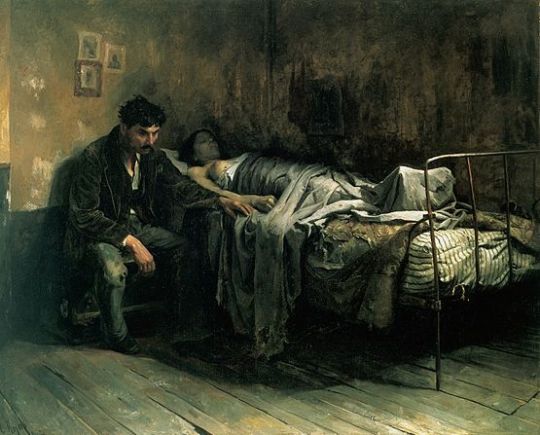
Miseria, 1886 | Cristóbal Rojas (1857-1890, Venezuela)

Böcklin's grave, 1901-02 (Staatliche Kunsthalle, Karlsruhe) | Ferdinand Keller (1876-1958, Germany)
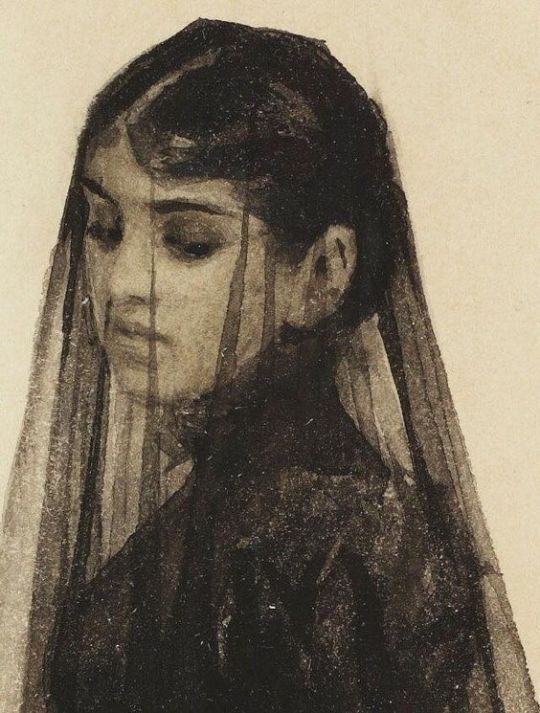
The widow (detail), 1882-83 | Anders Zorn (1860-1920, Sweden)

L’adultera o La femme de Claude, 1877 (Galleria d’Arte Moderna, Torino) | Francesco Mosso (1848-1877, Italia)

The funeral of Shelley, 1889 | Louis Édouard Fournier (1857-1917, France)

La peine de mort | Félicien Rops (1833-1898, Belgium)

Funeral at sea (on the death of the painter David Wilkie), 1842 (Tate Gallery, London) | William Turner (1775-1851, England)

La mort de Marat, 1793 (Musées royaux des Beaux-Arts, Bruxelles) | Jacques-Louis David (1748-1825, France)
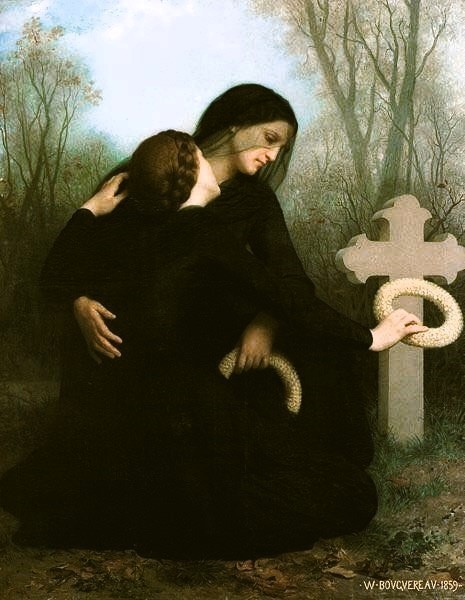
Le jour des morts, 1859 (Musée des Beaux-Arts, Bordeaux) | William Adolphe Bouguereau (1825-1905, France)
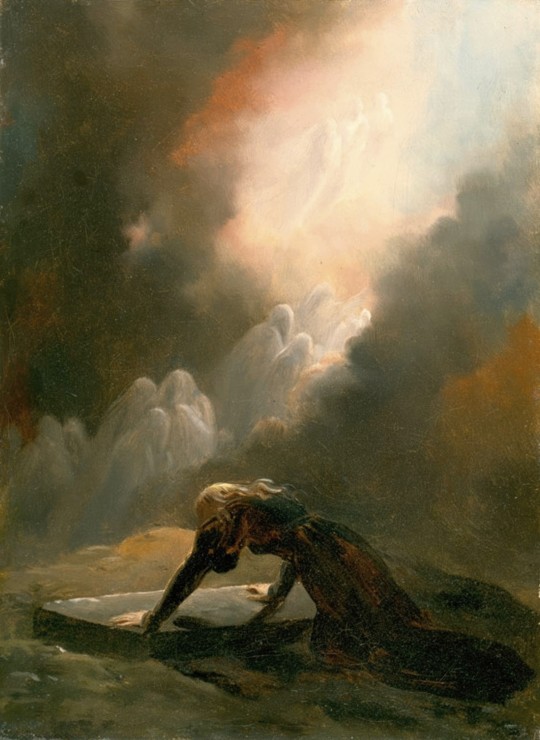
Bradamante at Merlin's tomb, 1820 | Alexandre-Évariste Fragonard (1780-1850, France)

Death on the pale horse, 1865 | Gustave Doré (1832-1883, France)

Il trionfo della morte, 1464 ca. (Palazzo Abatellis, Palermo) | Anonimo

Roman widow | Dante Gabriel Rossetti (1828-1882, England)

Cemetery in the moonlight, 1822 | Carl Gustav Carus (1789-1869, Germany)
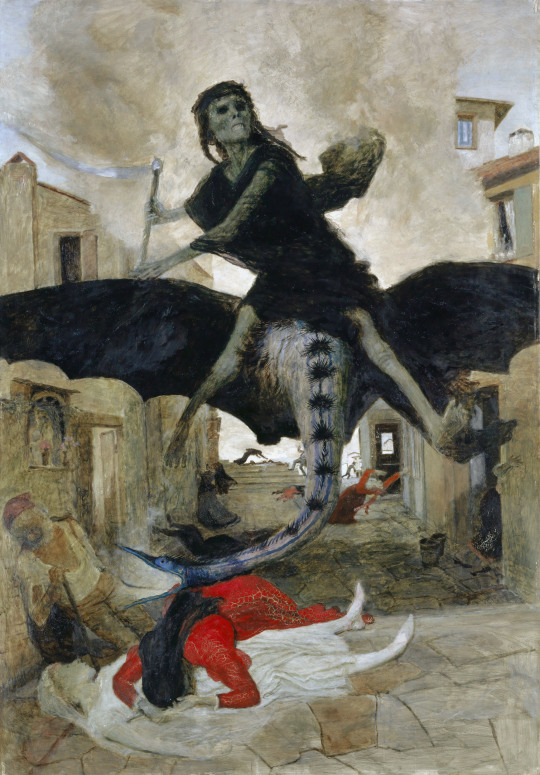
The plague, 1898 | Arnold Böcklin (1827-1901, Switzerland)
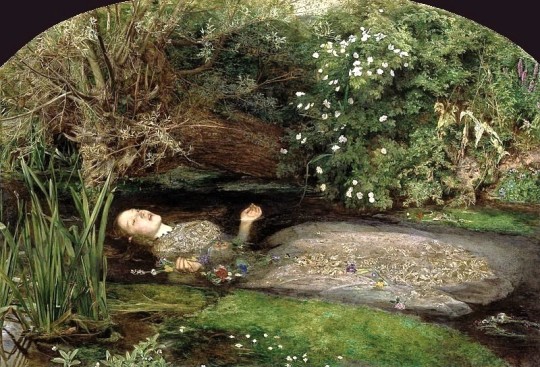
Ophelia, 1851-52 (Tate Britain, London) | John Everett Millais (1829-1996, England)
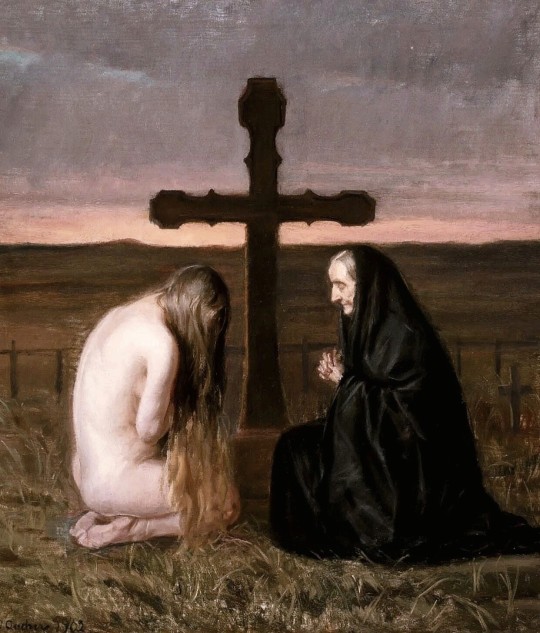
Grief, 1902 | Anna Ancher (1859-1935, Denmark)

The plague of pestilence, portfolio (two of seven etchings), 1920 | Stefan Eggeler (1894-1969, Austria)
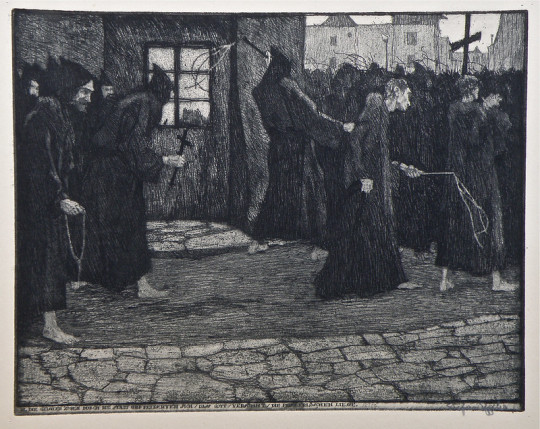
The plague of pestilence, portfolio (three of seven etchings), 1920 | Stefan Eggeler (1894-1969, Austria)

Dr. Nicolaes Tulp's anatomy lesson, 1632 | Rembrandt (1606-1669, Netherlands)

La sepoltura del conte di Orgaz (El Entierro del conde de Orgaz), 1586 (Chiesa di Santo Tomé, Toledo) | El Greco (1541-1614, Greece)

Woman on her deathbed, 1883 (Kröller-Müller Museum, Otterlo) | Vincent van Gogh (1853-1890, Netherlands)

Princess Tarakanova, in the Peter and Paul Fortress at the time of the flood, 1864 | Konstantin Flavitsky (1830-1866, Russia)
6 notes
·
View notes
Text


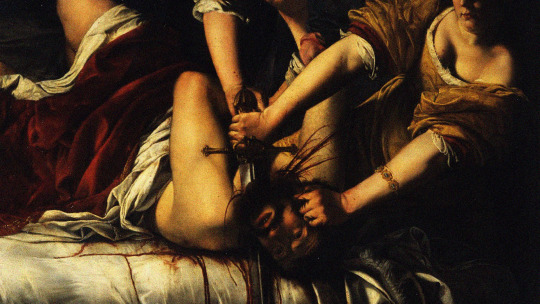
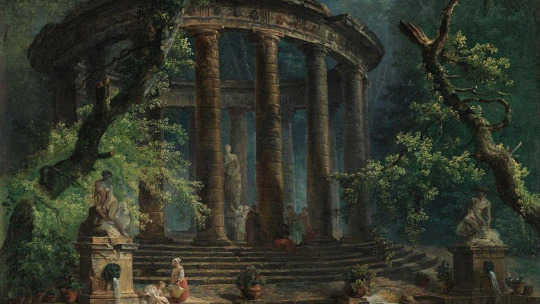


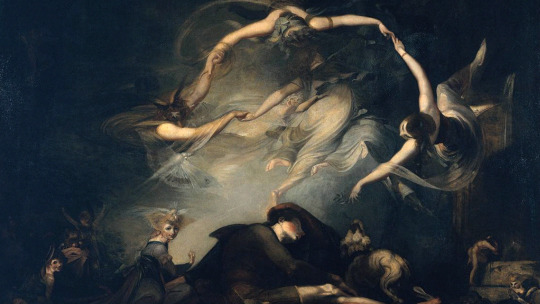
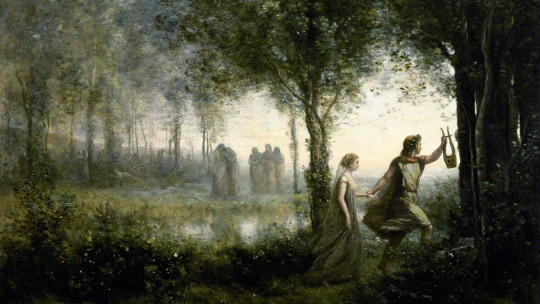
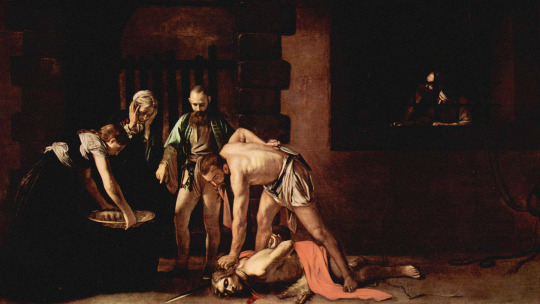
Paintings I've turned into desktop wallpapers * (note under the cut)
Isle of the Dead, Arnold Böcklin, Interior of the Hagia Sophia in Constantinople, Carlo Bossoli Judith Beheading Holofernes, Artemesia Gentileschi The Bathing Pool, Hubert Robert Souls on the Banks of the Acheron, Adolf Hirémy-Hirschl Shipping off the Eddystone Lighthouse, Vilhelm Melbye The Dream of the Shepherd, Johann Heinrich Fuessli Orpheus Leading Eurydice from the Underworld, Jean-Baptiste-Camille Corot The Beheading of John the Baptist, Michelangelo Merisi de Caravaggio
* Just this habit of mine that whenever I get drawn into a stunning artwork I encounter, mostly from the renaissance to neoclassical movements, I try to find the most high-definition photo of it to enhance. Thought of compiling them so far to share here, but do note that my enhancements may have already altered the true colors of the pieces to fit my personal preference. They have also been cropped according to the standard wallpaper dimensions of 1920x1080.
#my ask is always open if i mislabeled a piece!#or misspelled an artist's name#or miscategorized an art movement! i've only taken one semester of art appreciation so#art#tw death#tw blood#wallpapers#aesthetic#misc edit
6 notes
·
View notes
Text

Title: Isle of the Dead (6th version)
Artist: Arnold Böcklin and Carlo Böcklin
Year: 1901
Medium: Oil on board
Location: Hermitage Museum, St. Petersburg
1 note
·
View note
Text
Movimientos del Siglo XX Arte Metafísico
El nombre de Pintura metafísica surge durante el encuentro producido en 1917 entre Giorgio De Chirico, precursor del grupo, y Carlo Carrá, en el hospital militar de Ferrara Italia, en donde ambos se recuperaban de trastornos mentales.
Lo metafísicos pretendieron explorar la vida interior del subconsciente mezclada con objetos cotidianos representados fuera de los contextos habituales. Esto da lugar a una especie de sueño pintado, un sueño bastante lúcido teniendo en cuenta el naturalismo de los objetos y arquitecturas, y el ser representados en espacios concretos.
Por lo general, las pinturas de la metafísica se coordinan basándose en una imagen central y el resto se organiza alrededor. No existen líneas, sombras y mucha menos extravagancia. En cuanto a la perspectiva, esta es un tanto irónica y extraña, con una sensibilidad por las formas muy planas. En cuanto a los colores, son muy puros. En estas pinturas el ser humano no tiene cercanía con la divinidad, la presencia de este en la tierra se ilustra en las obras como la de un simple muñeco.
Giorgio de Chirico, a diferencia de muchos artistas de su generación, encontró poco que admirar en las obras de Cézanne y otros modernistas franceses, pero se inspiró en las pinturas del simbolista suizo Arnold Böcklin y el trabajo de artistas alemanes como Max Klinger. Su pintura El enigma de una tarde de otoño es considerada su primera obra metafísica; se inspiró en lo que de Chirico llamó una "revelación" que experimentó en la Piazza Santa Croce en Florencia.
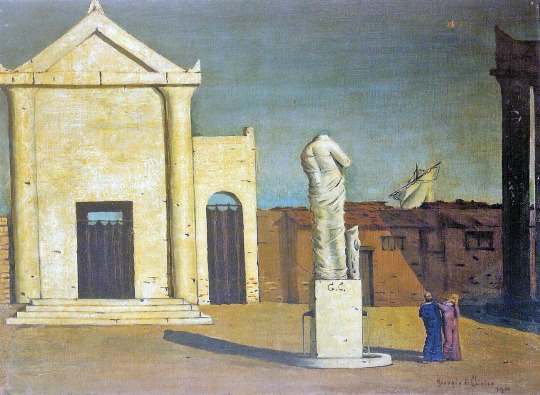
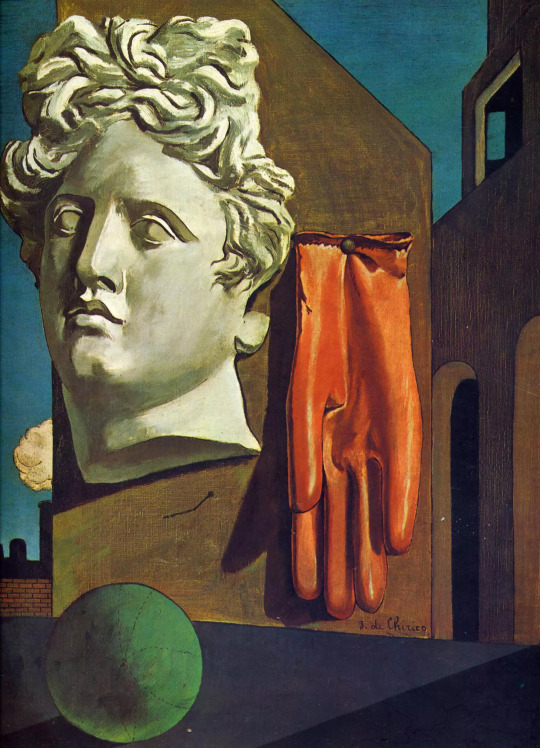
Carlo Carrá desarrolló una variante del estilo metafísico en el que el dinamismo de su trabajo anterior en el futurismo móvil a reemplazarlo por la inmovilidad. Carrá adoptó las imágenes de maniquíes de Chirico en espacios claustrofóbicos, pero sus obras carecían del sentido de ironía y enigma de De Chirico, y siempre mantuvo una perspectiva correcta.
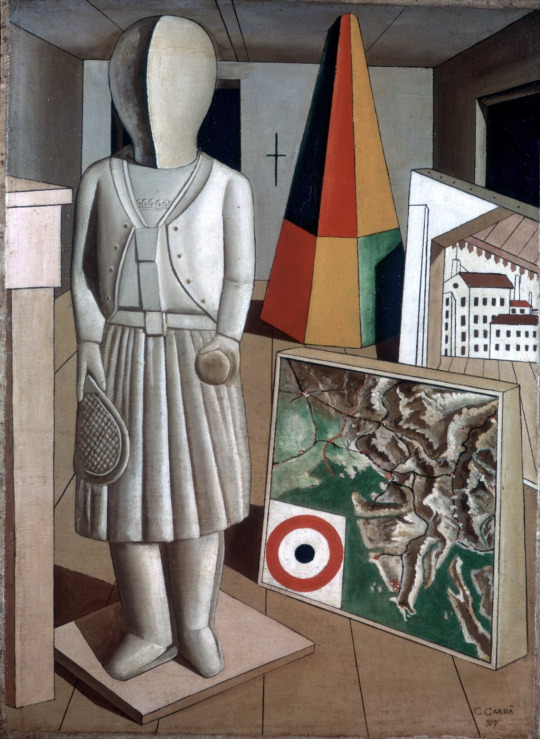
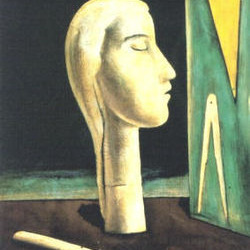
0 notes
Photo
Giorgio de Chirico
The Red Tower (La tour rouge)
Giorgio de Chirico’s enigmatic works of 1911 to 1917 provided a crucial inspiration for the Surrealist painters. The dreamlike atmosphere of his compositions results from irrational perspective, the lack of a unified light source, the elongation of shadows, and a hallucinatory focus on objects. Italian piazzas bounded by arcades or classical façades are transformed into ominously silent and vacant settings for invisible dramas. The absence of event provokes a nostalgic or melancholy mood as if one senses the wake of a momentous incident; if one feels the imminence of an act, a feeling of anxiety ensues.
De Chirico remarked that “every object has two appearances: one, the current one, which we nearly always see and which is seen by people in general; the other, a spectral or metaphysical appearance beheld only by some individuals in moments of clairvoyance and metaphysical abstraction, as in the case of certain bodies concealed by substances impenetrable by sunlight yet discernible, for instance, by x-ray or other powerful artificial means.”¹ Traces of concealed human presences appear in the fraught expanse of this work. One is the partly concealed equestrian monument often identified as Carlo Marochetti’s 1861 statue of King Carlo Alberto in Turin,² which also appears in the background of de Chirico’s The Departure of the Poet of 1914. In addition, in the left foreground, overpainting barely conceals two figures (or statues), one of which resembles a shrouded mythological hero by the 19th-century Swiss painter Arnold Böcklin. The true protagonist, however, is the crenellated tower; in its imposing centrality and rotundity it conveys a virile energy that fills the pictorial space.
Lucy Flint
1. Quoted in William Rubin, “De Chirico and Modernism,” in De Chirico, exh. cat. (New York: Museum of Modern Art, 1982), p. 57.
2. James Thrall Soby, De Chirico, exh. cat. (New York: Museum of Modern Art, 1955), pp. 49–50.
[x]

The Red Tower, 1913, Giorgio de Chirico
Medium: oil,canvas
112 notes
·
View notes
Text
MEINE VORBILDER, IDOLE, HELDEN ODER MENSCHEN, DIE ICH SEHR SCHÄTZE
Natürlich ist diese Liste nicht vollständig. Sicherlich könnte ich sie um viele Persönlichkeiten erweitern. Besonders bei Künstlern, Schriftstellern, Musikern und Schauspielern kämen sicherlich noch viel mehr bewundernswerte Menschen zusammen, die mein Leben mitbegleitet haben. Bei den eher unbekannten Namen habe ich die Funktion in Klammern daneben geschrieben. Einige Namen sind Legendengestalten oder biblische Figuren, zum Beispiel Heilige (HL). Menschen, die ich zum Beispiel während meiner Zeit als Redakteur oder anderwärtig persönlich kennen gelernt habe, sind zum Beispiel auf der Tumblr-Seite fett gekennzeichnet. Unter der Rubrik (Vormärz) versteht man die frühen Akteure der Demokratiebewegung, die leider nicht zum Zug kamen und stattdessen einem autokratischen System weichen mussten, die als Pseudodemokratie bis heute anhält. Im Klartext: Deutschland verträgt keine echte Opposition.
A: Jeanne d´Arc, Hannah Arendt, Ernst Moritz Arndt, Bettine von Arnim, AC/DC, Johann Valentin Andreae (Rosenkreuzer), Alexandra (Sängerin), König Arthus, Adele, Hirsi Ali, Charles Aznavour,
B: Hugo Ball (Schriftsteller), Marianne Bachmeier (Mutter Courage), Sebastian Bach, Gottfried von Bouillon (Kreuzritter), Friedrich Barbarossa, Clemens von Brentano (Dichter), G.L. von Blücher, F.W. von Bülow (Preußische Generäle der Befreiungskriege), Hildegard von Bingen, Beatles, Carl Ludwig Börne (1848ziger), Robert Blum (1848-Rebell), Ludwig van Beethoven, Arnold Böcklin, Max Brodt, David Bowie, Thomas Bernhard, Wilhelm Busch, James Baldwin, M. A. Bakunin (Anarchist), Boetius (Philosoph), Buena vista social Club, Josef Beuys, Samuel Beckett, Sebastian Brandt (Humanist)
C: Cicero, Paul Celan, Carl von Clausewitz (Oberst Befreiungskriege), Leonard Cohen, M. Caravaggio, John Cassavetes (Regis.), Karl August von Cohausen (Archäologe), Charlotte Corday (Rebellin 1790), Robert Crumb, Eric Clapton, Lowis Corinth, Joe Cocker, N.S. Chruschtschow, Sean Connery.
D: Denis Diderot (Aufklärer), Albrecht Dürer, Bob Dylan, Carl Theodor von Dalberg (Aufklärer), Dante, Dido (Sängerin), Alexander Dubcek, Doors,
E: Max Ernst, Hl. Elisabeth, Enya, Eisbrecher (Band), Michael Ende, Umberto Ecco, Joseph von Eichendorff,
F: Gottfried Fichte, Ernst Fuchs, Friedrich der Große, Georg Forster, Caspar David Friedrich, Fleetwood Mac,
G: Theo van Gogh, Franzisko de Goya, Gottfried Grabbe, Che Guevara, Siddharta Gautama, Karoline von Günderode (Dichterin), Georges I. Gurdjief (Mystiker), Matthias Grünewald, Artemisia Gentileschi (Malerin), Gandalf, Brüder Grim, Grimmelshausen, Ralf Giordano (Journalist), Green Day (Band), Florian Geyer (Rebellenanführer), A.N. von Gneisenau (General Befreiungskriege), M.S. Gorbatschow.
H: Hagen, Hermann Hesse, Peter Handke, Hölderlin, Heinrich Heine, E.T.A. Hoffmann, Gottfried Herder, Friedrich Hecker (1848-Rebell), Händel, Villard de Honnecourt (Gotik-Baumeister), Michel Houellebecq, Homer, Herodot, Klaus Heuser (BAB), Gorge Harrison, Andreas Hofer, Johnny Hallyday (Franz. Sänger), Friedensreich Hundertwasser, Werner Herzog, Elmar Hörig (Kultmoderator), Ulrich von Hutten (Humanist), Victor Hugo, Harro Harring (Vormärz),
I: Jörg Immendorff, Henryk Ibsen, Isaias (Prophet),
J. Jesus, Johannes der Täufer, Johannes der Evangelist, Jeremia (Prophet), C.G. Jung (Psychologe), Jennies Joplin, Friedrich Ludwig Jahn (Turnvater)
K: Karl Kraus, Theodor Körner, Franz Kafka, Frida Kahlo, Gustav Klimt, Charlotte von Kalb (Muse), Lee Krasner (Künstlerin), Rainhard Karl (Bergsteiger), Peter Keuer (Grünen-Gründer), Alfred Kubin,
L: Lukas, John Lennon, David Lynch, Flake Lorenz, Andreas von Lichnowski (1848ziger), Cyprian Lelek (1848ziger), Georg C. Lichtenberg, Gotthold Ephraim Lessing, Lanzelot, M.V. Llosa (Schriftsteller), Annie Lenox, Königin Luise, Ludwig A.W. von Lützow (Befreiungskriege), M. Lafayette (Fr. Staatsmann und Aufklärer) Franz Liszt, Led Zeppelin, Hanns Lothar (Schauspieler)
M: HL. Maria, HL. Maria Magdalena, Marcus, Matthäus, Matthäus Merian, Maria Sybilla Merian, Amadeus Mozart, Bob Marley, Edward Munch, Claude Monet, Albertus Magnus (Scholastiker), Merlin, Alma Mahler-Werfel (Muse), Meister Eckard (Mystiker), Moody Blues.
N: HL. Nikolaus, Novalis, V. Nabokov (Schriftsteller), Ningen Isu (Band), Nirvana, Agrippa von Nettesheim (Alchimist), Hannah Nagel (Künstlerin),
O: Josef Maria Olbrich (Jugendstilbaumeister), Rudolf Otto (Religionswissenschaftler), Oomph (Band), Oasis, Mike Oldfield,
P: Platon, Plotin, Pythagoras (Philosophen), Jean Paul, Plinius, Parzival, Tom Petty, Daniel Powter, Procol Harum, Pink Floyd,
Q: Queen,
R: Peter Paul Rubens, Rembrandt, Josef Roth, Ramstein, Philipp Otto Runge, Ludwig Richter, Rio Reiser, Ritter Roland, Rainer Maria Rilke, Erasmus von Rotterdam, Eric Rohmer, Ulrich Roski (Sänger), Rolling Stones, R.E.M. Lou Reed, Chris Rea, Petra Roth (Ex-OB Frankfurt/M)
S: Johann III Sobieski (polnischer König), Sunzi (chinesischer Philosoph), August Schöltis (Schriftsteller), Lou von Salome (Muse), B. Smetanar, Carlos Santana, Sappho (Dichterin), Schopenhauer, Helmut Schäfer (Staatsminister im Auswärtigen Amt) Sokrates, Egon Schiele, Madame de Stael, August Strindberg, Richard Strauss, Philipp Jacob Siebenpfeiffer (Vormärz), Helmut Schmidt, Subway to Sally (Band), Karl Ludwig Sand (Vormärz)
T: B. Traven (Schriftsteller), A. P. Tschechov, Ivan Turgenjev, Ludwig Tieck (Romantiker), HL. Judas Thaddäus, Hermes Trismegistos (Philosoph), P.I. Tschaikowski, William Turner, Lars von Trier (Regisseur)
U: Peter Ustinov, Ludwig Uhland, Siegfried Unseld (Verleger),
V: Luchino Visconti, Leonardo da Vinci, Velvet Underground, Vitruv, Vercingetorix, Francois Villon (Dichter), Walter von der Vogelweide, Robert Vogelmann (Menschenrechtsaktivist)
W: Wim Wenders, Richard Wagner, Otto Wagner (Jugendstilbaumeister) Wagakki-Band, Sara Wagenknecht, Ludwig Wittgenstein (Philosoph), Georg August Wirth (Vormärz),
X: Xhol (Band)
Y: Neil Young, Yvonne (Aktivistin der Gegenöffentlichkeit)
Z: Heinrich Zille, Carl Zuckmayer, Frank Zappa,
15 notes
·
View notes
Text

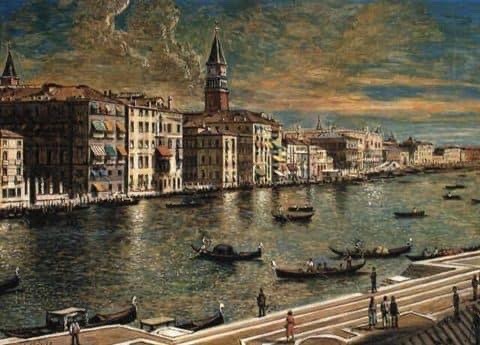


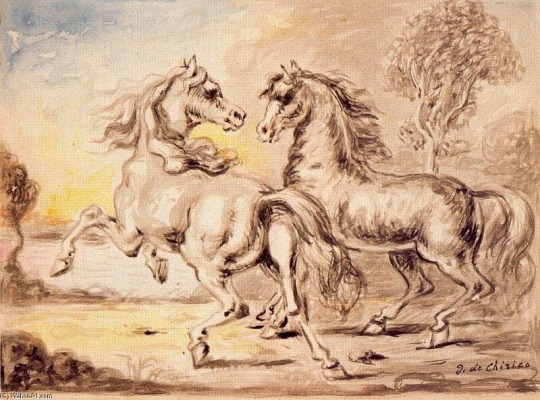
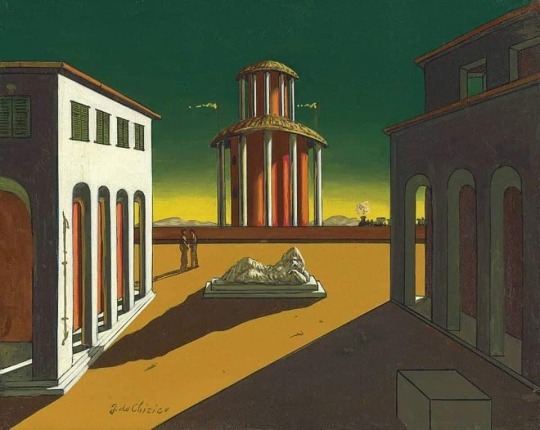


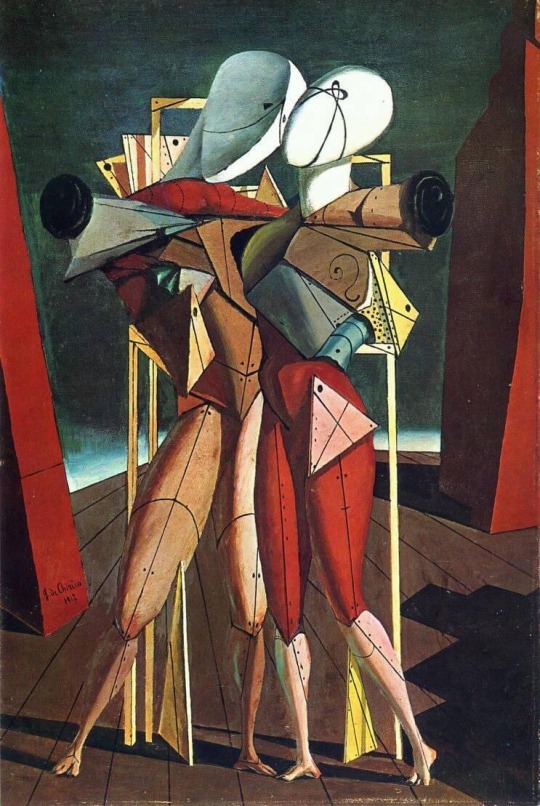

"Nosotros los metafísicos hemos santificado la realidad"
- Giorgio de Chirico
Un día como hoy 10 de julio de 1888 nació en Volos, Grecia, Giorgio de Chirico, hijo de padres italianos, vivo en Atenas hasta los 17 años.
En 1906 se fue a Múnich, donde se dejó influenciar por la pintura de Böcklin y Max Klinger. Ademas, admirador de las obras de Nietzsche y Schopenhauer.
Es considerado el padre de la Escuela Metafísica, junto a Carlo Carrá, movimiento que fue la antesala del surrealismo.
6 notes
·
View notes
Photo
“...Italian piazzas bounded by arcades or classical façades are transformed into ominously silent and vacant settings for invisible dramas. The absence of event provokes a nostalgic or melancholy mood as if one senses the wake of a momentous incident; if one feels the imminence of an act, a feeling of anxiety ensues.
De Chirico remarked that “every object has two appearances: one, the current one, which we nearly always see and which is seen by people in general; the other, a spectral or metaphysical appearance beheld only by some individuals in moments of clairvoyance and metaphysical abstraction, as in the case of certain bodies concealed by substances impenetrable by sunlight yet discernible, for instance, by x-ray or other powerful artificial means.”¹ Traces of concealed human presences appear in the fraught expanse of this work. One is the partly concealed equestrian monument often identified as Carlo Marochetti’s 1861 statue of King Carlo Alberto in Turin, which also appears in the background of de Chirico’s The Departure of the Poet of 1914. In addition, in the left foreground, overpainting barely conceals two figures (or statues), one of which resembles a shrouded mythological hero by the 19th-century Swiss painter Arnold Böcklin. The true protagonist, however, is the crenellated tower; in its imposing centrality and rotundity it conveys a virile energy that fills the pictorial space.”
— Lucy Flint

The Red Tower, Giorgio de Chirico, 1913
58 notes
·
View notes
Text
Month of Swiss Art
As I have announced before, I will be doing a “month of Swiss art”, presumably in October.
Gotik
Kathedrale von Lausanne
Manesse-Liederhandschrift
Konrad Witz
Renaissance
Antonio da Ponte
Carlo Maderno
Renaissance 1
Hans Holbein der Jüngere
Hans Ardüser dem Jüngeren
Niklaus Manuel
Barock
Carlo Maderno
Giovanni Serodine
Jean-Étienne Liotard
Barock 2
Fam. Orelli
Joseph Heintz
Anna Maria Barbara Abesch
Romantik
Johann Jakob Bodmer
Johann Heinrich Füssli
Marquard Wocher
Symbolismus
Arnold Böcklin
Ferdinand Hodler
Realismus
Albert Anker
Ernst Stückelberg
Rudolf Koller
(Neo) Klassizismus
Felix Maria Diogg
Leopold Robert
Impressionismus
François-Louis David Bocion
Alexandre Perrier
Frank Buchser
Post Impressionismus
Giovanni Giacometti
Cuno Amiet
René Auberjonois
Kubismus
Paul Klee
Alice Bally
Expressionismus
Johannes Itten
Fritz Baumann
Dadaismus
Sophie Taeuber Arp
Surrealismus
Meret Oppenheim
Max von Moos
Nouveau Realisme
Daniel Spoerri
Jean Tingueley
Pop art
Emilienne Farny
hugo Schumacher
Sylvie Fleury
Happening/Video art/performance art
Pippilotti Rist (Video art)
John Armleder (Performance art, fluxus)
Photorealism/Hyperrealism
Franz Gertsch
Andy Denzler
Installations
Thomas Hirschhorn
Urs Fischer
Christoph Büchel
Markus Ratz
Illustration
Annie Vallotton
Alois Cargiet
XXX
H. R. Giger
Design
Max Bill
Hans Erni
Landart
Kari Joller
Jean-Yves Piffard
Architecture
Le Corbusier
Herzog de Meuron
Mario Botta
Typefaces
Ernst Keller
Max Mieder
Josef Müller-Brockmann
Photography
Urs Lüthi
Karlheinz Weinberger
Annemarie Schwarzenbach
XXX
Alberto Giacometti
Varlin
XXX
Luciano Castelli
Comics
Zep (Philippe Chappuis)
Robert Lips
Felix Schaad
Yes, I know, there aren’t a lot of women on this list. It is sadly super difficult to both make a list with well known artist and to make it diverse. I am open to suggestions for more artists and more categories. It is obviously difficult in some cases to exactly define the “category” an artist is in, especially when it comes to modern art, as many artists made different works during their lifetime. Categories marked with an “XXX” are there as a filler and aren’t relevant. The order of these is also up to debate, they are roughly chronological in the beginning but not anymore in the end.
---- This is the final list, I won’t make any changes anymore, except moving the different artists into other categories if I see it fit ----
82 notes
·
View notes
Photo

Giorgio de Chirico ♦️♦️♦️♦️♦️♦️♦️♦️♦️♦️♦️♦️♦️♦️♦️♦️ Volos 1888 🇬🇷 Rom 1978 🇮🇹 🔻🔻🔻🔻🔻🔻🔻🔻🔻🔻🔻🔻🔻🔻🔻🔻 Der italienische #Maler und #Grafiker #GiorgiodeChirico wird in Volos, Griechenland geboren. Er besucht in Athen die Malklasse, danach reiste er nach München, wo er 1906-09 an der #AkademiederBildendenKünste studierte. In München sieht er erstmals die Malerei von Arnold Böcklin, Max Klinger und Alfred Kubin, die in stark beeindruckt und durch die er wichtige Anregungen erhält. Daneben beschäftigt sich #GiorgiodeChirico mit Musik sowie den philosophischen Schriften von Arthur Schopenhauer und besonders Friedrich Nietzsche.1909 geht Giorgio de Chirico nach #Italien er wohnt in #Mailand besucht #Turin #Florenz und andere Städte. 1911-15 ist de Chirico in #Paris Er nimmt an den Ausstellungen des Salon d’Automne und des Salon des Indépendants teil. 🔻🔻🔻🔻🔻🔻🔻🔻🔻🔻🔻🔻🔻🔻🔻🔻 Thematisch und atmosphärisch sind seine Bilder durch die Lektüre Friedrich Nietzsches mit bedingt. Wirklichkeit und #Traumwelt vermengen sich, er malt phantastische Idealarchitekturen und streng perspektivisch aufgebaute Stadtansichten und Landschaften, in denen wie verloren einzelne Statuen und die Manichini gesichtslose Gliederpuppen stehen. Der Künstler legt dabei immer besonderen Wert auf die malerische Qualität seiner Bilder.1917 lernt Giorgio de Chirico als Soldat im Militärhospital in Ferrara den Maler Carlo Carrà kennen, der sich ihm anschließt. Nach dem Krieg formulieren sie die theoretischen Grundsätze der "Pittura Metafisica", die de Chirico in Artikeln für die Zeitschrift "Valori Plastici" veröffentlicht. 1925 geht Giorgio de Chirico erneut nach Paris. Er ist befreundet mit den surrealistischen Malern Max Ernst, René Magritte, Yves Tanguy und Salvador Dalí. Die Surrealisten schätzen seine Malerei ebenso wie die Maler der Neuen Sachlichkeit und des Magischen Realismus.1935-37 hält sich de Chirico in den #USA auf, kehrt dann nach Italien zurück und lässt sich 1945 endgültig in #Rom nieder. Giorgio de Chirico stirbt am 20.11.1978 in Rom. #kunstszene #folgensiederkunst (na mieste Greece) https://www.instagram.com/p/BxW4s2QAiNK/?igshid=a2a19u2k2ozn
#maler#grafiker#giorgiodechirico#akademiederbildendenkünste#italien#mailand#turin#florenz#paris#traumwelt#usa#rom#kunstszene#folgensiederkunst
1 note
·
View note
Text
Alban Nikolai Herbst Oh dieser mächtige Raum! Für eine Poetik des Phantastischen
[Vortrag gehalten in Linz im Mai 2004 auf dem Fantastik-Symposion des Ober- österreichischen Landesmuseums. Ersterschienen als Essay in die horen Nr. 27, 2005.]
Die Metaphysiker auf Tlön suchen nicht die Wahrheit, ja nicht einmal die Wahrscheinlichkeit: sie suchen das Erstaunen. Sie sind der Auffassung, daß die Meta- physik ein Zweig der phantastischen Literatur sei.1 Borges
Sehr verehrte…
View On WordPress
#Akt der Beschwörung#Alban Nikolai Herbst#Alfred Wolkenstein#Alien#Ambivalenz#Anderswelt-Trilogie#André Breton#Andy Warhol Dracula#ANH#Apollinaire#Arnold Böcklin#Azreds Buch#Barbara Bongartz Inzest#Boromäiasche Insel#Carlo Schmidt#Cet obscure objet du désir#Charles Baudelaire#cthulhu Räume#Cyber-Technologie#Cyberraum#Das Flirren im Sprachraum#Das Holzschiff#das Ungeheure#David Cronenberg#Der Mann Moses#Die Dschungel.Anderswelt#Die Ungetrösteten Roman#Edgar Allan Poe#Essay#eXistenZ
0 notes
Text



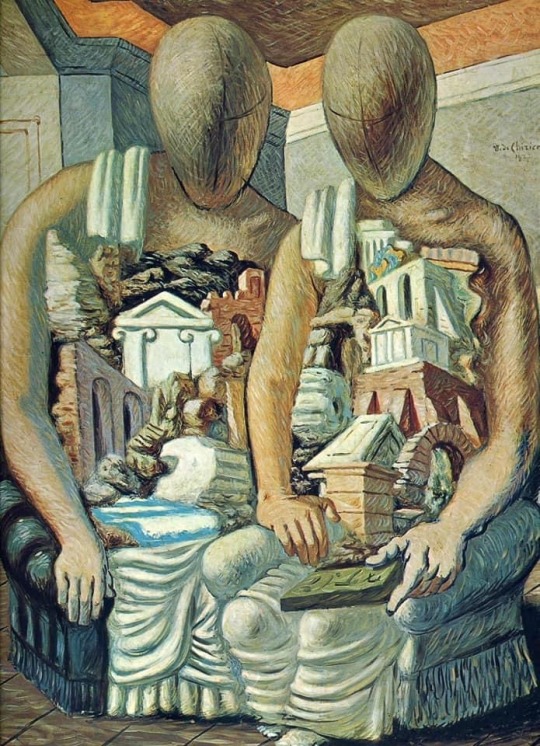



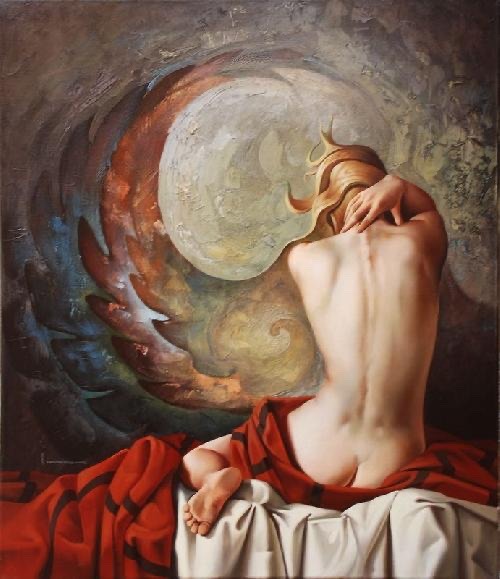
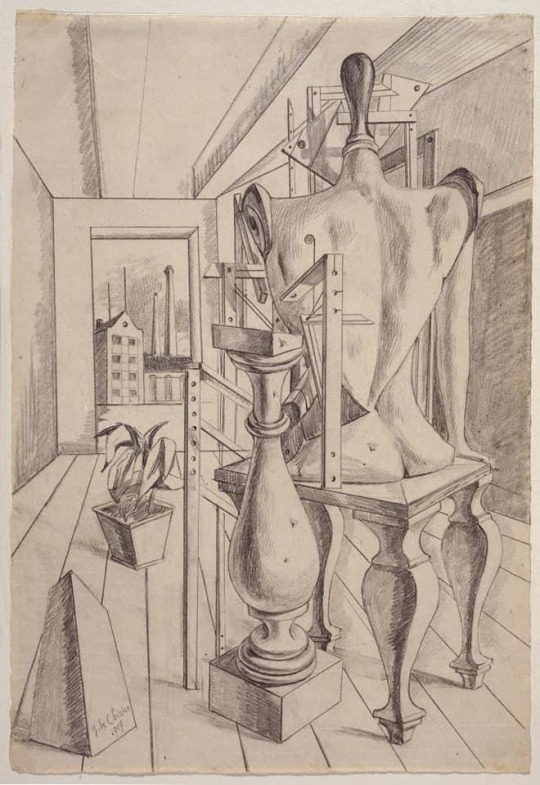

"Nosotros los metafísicos hemos santificado la realidad"
- Giorgio de Chirico
En la ciudad de Roma, Italia muere a los 90 años de edad #UnDiaComoHoy 20 de noviembre en 1978 el artista griego de ascendencia italina Giorgio de Chirico, originario de Volos, Grecia, Giorgio vivo en Atenas hasta los 17 años.
En 1906 se fue a Múnich, donde se dejó influenciar por la pintura de Böcklin y Max Klinger. Ademas, admirador de las obras de Nietzsche y Schopenhauer.
#DeChirico estaba bastante adelantado a su tiempo. Fundó la escuela Metaphysical en la década de 1910, aproximadamente una década antes de que comenzara el surrealismo. Las obras oníricas inspirarían más tarde a los surrealistas fascinados por el análisis de los sueños. Es considerado el padre de la Escuela Metafísica, junto a Carlo Carrá, movimiento que fue la antesala del surrealis
8 notes
·
View notes
Photo

Giorgio de Chirico ♦️♦️♦️♦️♦️♦️♦️♦️♦️♦️♦️♦️♦️♦️♦️♦️ Volos 1888 🇬🇷 Rom 1978 🇮🇹 🔻🔻🔻🔻🔻🔻🔻🔻🔻🔻🔻🔻🔻🔻🔻🔻 Der italienische #Maler und #Grafiker #GiorgiodeChirico wird in Volos, Griechenland geboren. Er besucht in #Athen die Malklasse, danach reiste er nach #münchen wo er 1906-09 an der #AkademiederBildendenKünste studierte. In München sieht er erstmals die Malerei von Arnold Böcklin, Max Klinger und Alfred Kubin, die in stark beeindruckt und durch die er wichtige Anregungen erhält. Daneben beschäftigt sich #GiorgiodeChirico mit Musik sowie den philosophischen Schriften von Arthur Schopenhauer und besonders Friedrich Nietzsche.1909 geht Giorgio de Chirico nach #Italien er wohnt in #Mailand besucht #Turin #Florenz und andere Städte. 1911-15 ist de Chirico in #Paris Er nimmt an den Ausstellungen des Salon d’Automne und des Salon des Indépendants teil. 🔻🔻🔻🔻🔻🔻🔻🔻🔻🔻🔻🔻🔻🔻🔻🔻 Thematisch und atmosphärisch sind seine Bilder durch die Lektüre Friedrich Nietzsches mit bedingt. Wirklichkeit und #Traumwelt vermengen sich, er malt phantastische Idealarchitekturen und streng perspektivisch aufgebaute Stadtansichten und Landschaften, in denen wie verloren einzelne Statuen und die Manichini gesichtslose Gliederpuppen stehen. Der Künstler legt dabei immer besonderen Wert auf die malerische Qualität seiner Bilder.1917 lernt Giorgio de Chirico als Soldat im Militärhospital in Ferrara den Maler Carlo Carrà kennen, der sich ihm anschließt. Nach dem Krieg formulieren sie die theoretischen Grundsätze der "Pittura Metafisica", die de Chirico in Artikeln für die Zeitschrift "Valori Plastici" veröffentlicht. 1925 geht Giorgio de Chirico erneut nach Paris. Er ist befreundet mit den surrealistischen Malern Max Ernst, René Magritte, Yves Tanguy und Salvador Dalí. Die Surrealisten schätzen seine Malerei ebenso wie die Maler der Neuen Sachlichkeit und des Magischen Realismus.1935-37 hält sich de Chirico in den #USA auf, kehrt dann nach Italien zurück und lässt sich 1945 endgültig in #Rom nieder. Giorgio de Chirico stirbt am 20.11.1978 in Rom. #kunstszene #folgensiederkunst (na mieste Greece) https://www.instagram.com/p/BxW3TZDgWAB/?igshid=1x5b4tfvreh1x
#maler#grafiker#giorgiodechirico#athen#münchen#akademiederbildendenkünste#italien#mailand#turin#florenz#paris#traumwelt#usa#rom#kunstszene#folgensiederkunst
1 note
·
View note